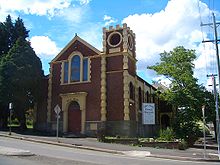
Deconsecration, also referred to as decommissioning or secularization (a term also used for confiscation of church property),[1] is the removal of a religious sanction and blessing from something that had been previously consecrated for spiritual use.
In particular, church and synagogue buildings no longer required for religious use are deconsecrated for secular use or demolition.[2][3]
Roman Catholicism
[edit]According to the canon law of the Roman Catholic church, an altar, chapel, or shrine may be deconsecrated if it can no longer be used for divine worship and cannot be restored or if other serious reasons suggest that worship is no longer possible.
For the bishop to issue a decree declaring the church relegated to a "Secular but not unbecoming purpose," he must consult the presbyteral council of the diocese, obtain the consent of those who may have legal rights, and ensure that the good of Souls will not be harmed.[4] Accordingly, no formal deconsecration rite is needed.[5]
Altars automatically lose their consecration if they are significantly damaged, one of its anointed corners has been broken or removed, or have been permanently relegated to secular usage, either de facto or by a decree of the bishop.[6]
See also
[edit]References
[edit]- ^ Donald S. Armentrout and Robert Boak Slocum (2000). "Secularizing a Consecrated Building". An Episcopal Dictionary of the Church. The Domestic and Foreign Missionary Society.
This service is used to deconsecrate and secularize a consecrated building that is to be taken down or used for other purposes.
- ^ "Deconsecration of a London Church". The New York Times. November 3, 1876.
- ^ Temple B'nai Israel to conduct last service in synagogue Sunday, By KATE DAY SAGER Olean Times Herald Dec 9, 2020
- ^ Canon 1222 §1
- ^ de Wildt, Kim (2020). "Ritual Void or Ritual Muddle? Deconsecration Rites of Roman Catholic Church Buildings". Religions. 11 (10). Switzerland: 517. doi:10.3390/rel11100517. ISSN 2077-1444.
- ^ Canon 1212